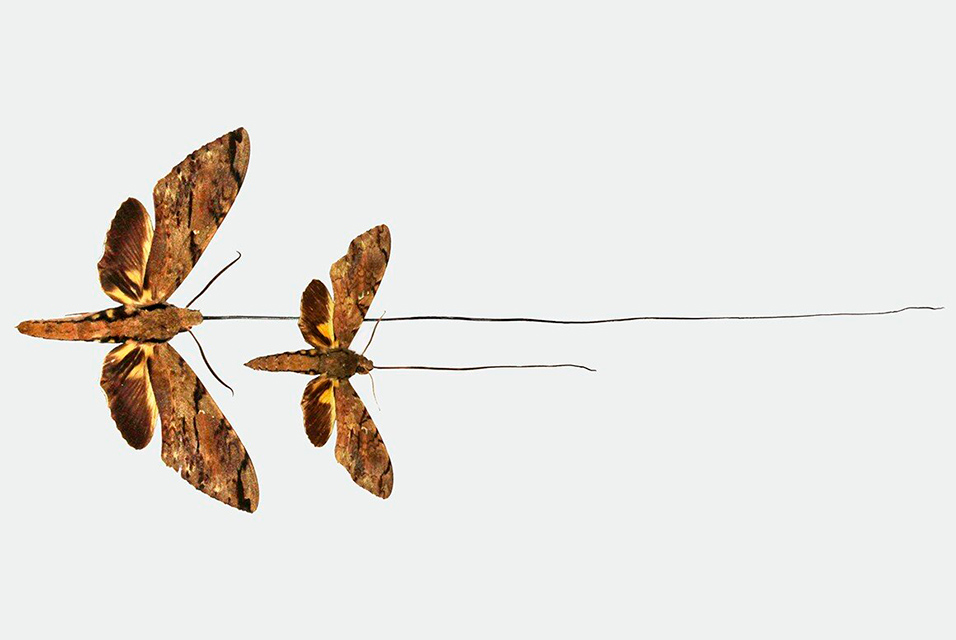LONDON.- A Madagascan hawkmoth, whose existence was predicted by Darwin and Wallace, has now been recognized as a new species.
Known as Wallace's sphinx moth, the moth is famous for its enormous tongue—the longest of any insect—that uniquely can reach the bottom of the nectar tubes of the Madagascan star orchid.
In 1862, when Charles Darwin was sent a specimen of orchid from Madagascar with its incredible nectar tube measuring a full 30 centimeters long, he exclaimed in a letter to a friend: "Good heavens, what insect can suck it!"
Darwin speculated it would take a moth with an extraordinarily long tongue to reach the nectar that fills the bottom of these tubes.
Five years later in 1867, Alfred Russel Wallace also considered this impressive orchid, predicting that the moth would be similar to a hawkmoth with a long proboscis found on the African continent. Wallace in turn wrote: "That such a moth exists in Madagascar may be safely predicted, and naturalists who visit that island should search for it with as much confidence as astronomers searched for the planet Neptune,—and they will be equally successful."
Finally he has been proven right.
When the moth that pollinated these orchids was finally described by Karl Jordan and Lord Walter Rothschild in 1903, it was placed as a subspecies of Morgan's sphinx moth, which they then combined into their new genus Xanthopan, the type specimen of which from West Africa is in the collections. They called the Malagasy moth Xanthopan morgani praedicta, meaning "predicted moth," in honor of Wallace's prediction of its existence, not mentioning Darwin.
Now a new study looking into the moth's genetic and physical differences has found that the Madagascan moth is not actually a mere subspecies of Morgan's sphinx moth, but instead a full species in its own right, now named Xanthopan praedicta.
Dr. David Lees is a curator of moths at the
Museum, and one of the authors on the paper by a team led by Prof Joël Minet and published in the journal Antenor.
"Imagine my excitement as I unrolled and measured the proboscis of a male Xanthopan in the Madagascan rainforest, realizing that it was probably the global record holder," says David. "The taxonomic change we now propose finally gives long-deserved recognition, at the species level, to one of the most celebrated of all Malagasy endemics."
Evolving in synch
Wallace's sphinx moth is only found on Madagascar, and its life is intimately intertwined with the plants that live there.
Evolving together over time, the moth and the star orchid have influenced each other's biology in a unique but still one-sided pollinator and plant co-evolutionary relationship. The tongue of the moth increased in length in step with the long nectar tube of the orchid until, eventually, the orchid became wholly reliant on the pollination services of the moths. The moths, however, are still able to pollinate other plants which also have long nectar tubes.
Unrolling enormous moth tongues
In the wild, the moth's tongue is so big it is too unwieldy to fly with it extended. Its extraordinary length also makes the moths vulnerable to predation as they feed as bats, and perhaps even lemurs, can snatch them out of the air when they home in on the orchids.
To reduce this risk of being eaten, the moth unrolls the proboscis only when they approach the flower and as soon as it finishes it rolls it back up.
While this strategy means that the moth is less likely to be predated on in the wild, it can make things a little tricker for those studying them in museums.
When looking at the moth specimens held in museum collections, the researchers needed to unroll the long tongue. To do this, they dipped the head of the almost 100 specimens of the moth from Africa and the Comoros, or Madagascar, in a bath of water overnight to soften the proboscis and allowing the researchers to measure its length. In the field in Madagascar, David unrolled the tongues of another 30 specimens before marking and releasing them.
Varying from 15 to 28.5 centimeters long, the moth proboscises were, however, too long to store extended in the existing drawers, so the researchers decided to roll them back in by placing the moth's head back in water.
What makes the moth a distinct species?
Making the decision to name something as a new species requires a careful look at how different it is from similar species.
As life evolves, populations of organisms drift apart from each other and it's not always clear where one species ends and another begins. In fact, the concept of a species is a human construct, albeit a handy one when classifying life.
A broadly agreed definition of a species is a group of similar individuals that can breed with each other to create viable offspring.
Given that no one has tested if a hawkmoth from Madagascar and a hawkmoth from Africa can interbreed to make viable offspring, researchers examined the Madagascan moth in minute detail before they could make the decision to raise it to full species level.
The team found 25 morphological differences (how its body looks) between the two moths, including significant differences in shape of male and female genitalia, wing shape and the color patterns especially underneath.
"The underside of the hawkmoth from Madagascar is pinkish, while the underside of the hawkmoth from Africa is whitish or yellowish," says David, adding that Wallace's sphinx moth also has a unique configuration of black markings on the upperside of its forewings, probably adaptations for camouflage to sit on the bark of different trees.
Perhaps the most striking difference though was in the proboscis, which on average were 6.6 centimeters longer in all the Malagasy moths the team measured than any of Morgan's sphinx moth from Africa and the Comoros.
In addition to assessing how the moth looks, the researchers also studied the differences in the DNA, a technique called DNA barcoding.
DNA barcoding has shown that the Madagascan moth is at least 7.6% divergent from the African hawkmoth. "This is much more than what you would expect between different species," says David.
The research also found that there was no difference in DNA barcodes between all the Wallace's sphinx moths found across all of Madagascar. "The fact that I found one of these moths in a remote forest in the south-west of Madagascar suggests it can fly hundreds of kilometers," says David.










